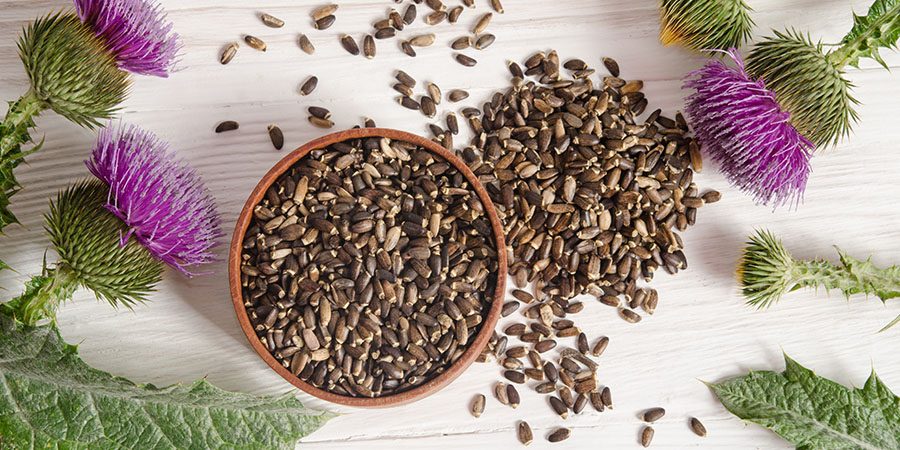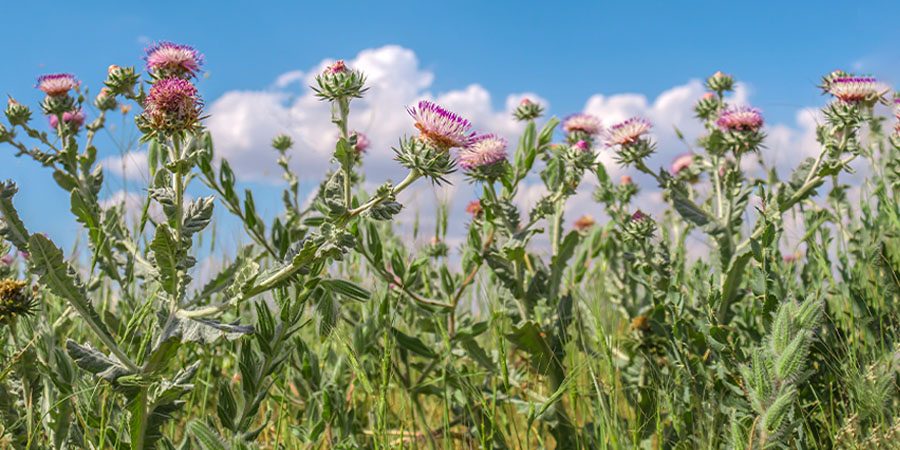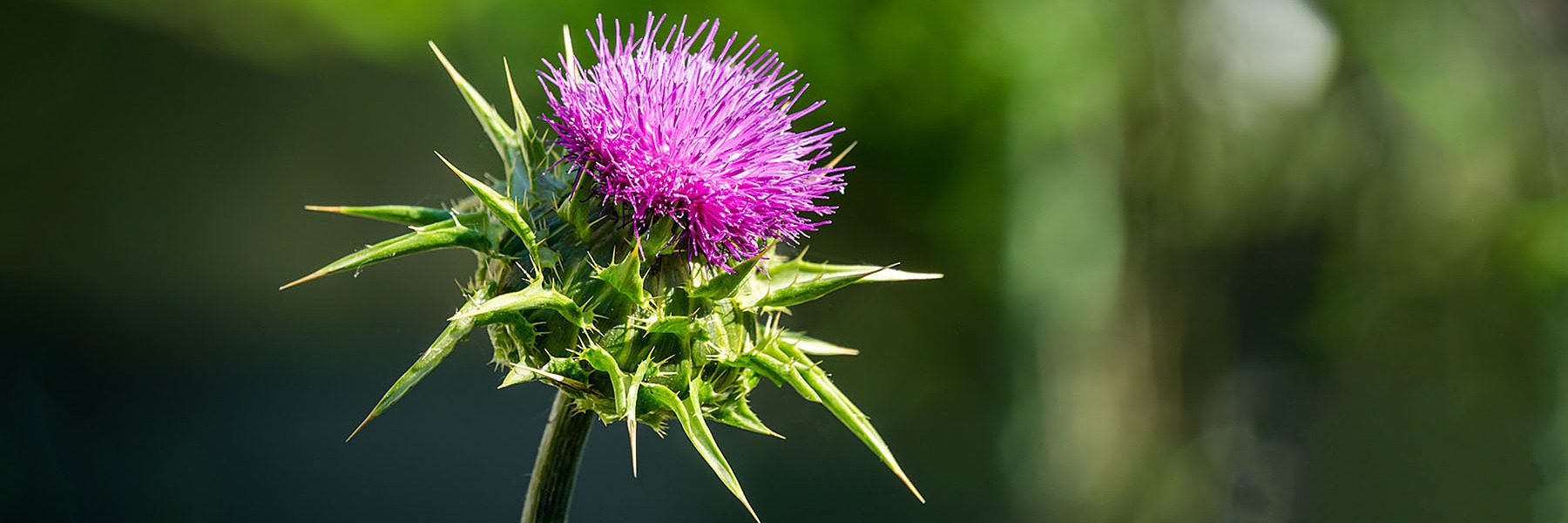The Benefits of Milk Thistle
In the world of herbs, the humble milk thistle, or Silybum marianum, stands tall and proud as a common plant with remarkable benefits. This flowering thistle has a long history of traditional use and is especially renowned for its potential to support liver health and overall well-being.1
In the whirlwind of modern living, our bodies deserve a nourishing, gentle cleanser, and milk thistle emerges as the perfect ally, providing the revitalizing touch we all crave.
In this article:
- What Is Milk Thistle?
- Milk Thistle Benefits
- How to Take Milk Thistle
- Research Studies on Milk Thistle
- Side Effects: Is Milk Thistle Safe?
- Growing and Harvesting Milk Thistle
What Is Milk Thistle? Characteristics of the Plant
Also known as St. Mary's thistle or holy thistle, milk thistle is a herbaceous plant belonging to the Asteraceae family. Native to Mediterranean regions, the plant is characterized by its striking purple flowers and glossy green leaves, which are typically marked with milky white veins—hence its name.2
According to folk tradition, milk thistle's characteristic violet flowers and white-veined leaves came from the Virgin Mary's milk.3
Silymarin—which is actually a group of flavonolignans including silibinin, silidianin, and silicristin—exhibits significant antioxidant activity and is thought to be largely responsible for milk thistle’s noteworthy ability to support liver health.4

Milk Thistle Benefits
If this plant is new to you, you may be wondering, “what is milk thistle good for?” Herbalists and healers have been using this nourishing herb to support physical health and well-being for over 2000 years.5 The following milk thistle health benefits give just a brief overview of the healing magic of this herbal ally.
What are the benefits of milk thistle?
-
Milk Thistle for Liver Health: The liver is one of the body's vital organs, responsible for detoxifying harmful substances, metabolizing nutrients, and regulating various physiological processes. Milk Thistle's primary and most well-known benefit is its ability to promote liver health. Silymarin, the active component in milk thistle, is a potent antioxidant that helps protect the liver from damage caused by free radicals and toxins.6
-
Milk Thistle for Skin Health: Milk thistle’s antioxidant properties contribute to its ability to support healthy skin. Studies have shown it has the power to protect against harmful sun exposure and slow the aging process of the skin.7 In fact, the cast of the 2023 blockbuster hit, Barbie, regularly drank milk thistle tea to promote a bright and clear complexion.8
-
Milk Thistle for Weight Loss: Milk thistle has a gently cleansing and detoxifying action that can contribute to healthy body weight. Once again, this is believed to happen primarily by way of the liver. By supporting the optimal function of the liver, milk thistle ensures that detoxification pathways and metabolic processes, including fat metabolism, are in healthy working order.9
-
Milk Thistle for Detoxification: Milk thistle’s antioxidant properties and high concentration of biological active compounds like silymarin give it a gentle yet powerful cleansing effect, especially for the liver. Because the liver is one of the most important organs of detoxification, this cleansing quality naturally extends throughout the body.10
-
Milk Thistle for Digestive Support: Milk thistle’s affinity for healthy liver metabolism extends to support the metabolism that happens throughout the body, including in the digestive tract. Here, it stimulates the production of digestive juices and contributes towards the effective breakdown of foods.11
-
Milk Thistle’s Antioxidant Properties: Milk Thistle exhibits strong antioxidant properties that benefit the entire body. Antioxidants play a crucial role in neutralizing free radicals, which are unstable molecules that can damage cells and contribute to various diseases and premature aging. The use of milk thistle harnesses the power of antioxidants to protect the cells and tissues from oxidative stress.12
Milk Thistle in Ayurveda
Milk thistle isn’t typically considered a traditional Ayurvedic herb, as its historical use originated mainly in Western European regions. But through the lens of bioregional Ayurveda—the practice of working with the plants that grow in one’s local ecosystem—milk thistle has much to offer.
From an Ayurvedic perspective, milk thistle has a cooling and gently cleansing effect on the body. This quality is especially balancing for pitta dosha, though it can also be helpful for both vata and kapha.13
Considered a rasayana14, milk thistle is known to have a rejuvenating effect—especially for the liver—while also helping to remove accumulated toxins (ama) with its gentle cleansing properties.
As a liver supporting herb, milk thistle helps to kindle the bhuta agnis seated in the liver, which play a crucial role in breaking down and transforming the food we eat to support healthy metabolic function.

How to Take Milk Thistle
Throughout history, the leaves, stems, and flowers of the milk thistle plant have been used to support the body in a variety of ways. The entire plant is edible and usable—from the large taproot it produces to its leaves that can be eaten as a source of nutrient-rich greens.
The potent seed is the most commonly known and used part of the plant and is recognized to contain the highest concentration of silymarin.
While there are endless ways to receive the benefits of this herb, milk thistle supplements and milk thistle extract have become increasingly sought after options thanks to their ease and convenience. Drinking herbal milk thistle tea is also a wonderful and traditional method of consumption.
Drink to Your Health: Milk Thistle in Masala Chai and Bitter & Bold
If you’re looking for a truly tasty and satisfying way to benefit from this herb’s health-promoting properties, look no further than our new Masala Chai and Bitter & Bold drink mixes.
In comparison to an extracted constituent, the whole plant contains everything that is needed for proper absorption, digestion, and assimilation.
Drinking herbal blends also provides the opportunity to taste the herbs, which, in Ayurveda, is believed to be an important part of the digestive process.
Masala Chai and Bitter & Bold combine milk thistle with other nourishing herbs and adaptogens to create two unique and delicious beverages that can be enjoyed warm or iced, with or without milk and sweetener.
Whether used in place of or in addition to coffee, they offer a healthy and satisfying way to elevate your day and nourish your health with the help of milk thistle and other potent herbal ingredients.
Research Studies on Milk Thistle
Milk thistle and its active constituent silymarin have been the subject of several research studies exploring their benefits for supporting the liver and beyond. Below are a few recent studies that summarize some of these findings:
- Efficacy of Silymarin in Patients with Non-Alcoholic Fatty Liver Disease. BMC Abstract. March 10, 2023.15
- Biochemical Profile of Milk Thistle (Silybum Marianum L.) with Special Reference to Silymarin Content. PubMed Abstract. January, 2021.16
- Skin Protective Activity of Silymarin and its Flavonolignans. PubMed Abstract. March 2019.17
- Silymarin as a Natural Antioxidant: An Overview of the Current Evidence and Perspectives. PubMed Abstract. March 2015.18
Side Effects: Is Milk Thistle Safe?
When taken in moderation, milk thistle is generally regarded to be a safe, gentle, and beneficial way to support overall health and well-being. In very rare cases, adverse effects of milk thistle have included headache, diarrhea, and digestive discomfort.19
Contraindications
Milk thistle is generally very well tolerated. In some cases, caution is recommended, specifically for anyone with a potential allergy, diabetes, or a hormone-sensitive condition (milk thistle can have estrogenic effects).20
Always consult your healthcare practitioner if you have questions related to your particular condition, or if you are taking prescription medications. Additionally, those who are pregnant or breastfeeding should always consult with a doctor or healthcare professional before using milk thistle or any other herb.

Growing and Harvesting Banyan’s Milk Thistle
Milk thistle is typically considered invasive and the bane of most growers. With its high seed production and tendency to germinate and reproduce rapidly, it is not usually a crop that is intentionally planted, but rather actively eliminated from the fields.
The trick to keeping the thistle from becoming invasive is to harvest before the seeds mature and fall from the plant, which typically occurs in late spring after it flowers. Milk thistle grows as an annual in most locations and will die back after flower and seed production has stopped.
Our milk thistle is grown and harvested in Europe. Like most thistles, it is very prickly by nature so care and protective clothing need to be worn when working with the plant.
Sustainability of Milk Thistle
Our organic milk thistle is sustainably sourced and fairly traded. Because of its prolific nature, there are no sustainability concerns or issues with over harvesting milk thistle.
As a part of a larger conversation regarding the sustainability of Ayurvedic herbs, it is important to understand where and how plants are grown and harvested when you’re considering how to choose a high-quality milk thistle supplement.
We ensure sustainability by sourcing the botanicals used in our products from privately owned farms where each plant has been cultivated or harvested from legal wild-craft sourcing. Our herbs and ingredient-producing plants are harvested at optimal times, using environmentally sustainable practices sensitive to the long-term health of the plants.

